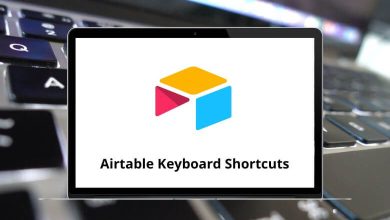Download Delphi Shortcuts PDF
Table of Contents
Learn Delphi RAD Studio Shortcuts for Windows
Most used Delphi Shortcuts
| Action | Delphi Shortcuts |
|---|---|
| Selects parent control in design mode | Esc |
| In Object Inspector activates incremental search for properties | Tab |
| Invoke code templates also called code snippets | Ctrl + J |
| Delete text from the cursor position until the end of the word | Ctrl + T |
| Incremental search | Ctrl + E |
| Delete current line | Ctrl + Y |
| Invoke buffer window when the focus is on the editor | Ctrl + B |
| Insert a new GUID at the cursor position | Ctrl + Shift + G |
| Indent the currently selected block | Ctrl + Shift + I |
| Unindent the currently selected block | Ctrl + Shift + U |
| Indent the currently selected block or current line in case of no selection | Ctrl + K + I |
| Unindent the currently selected block or current line in case of no selection | Ctrl + K + U |
| Invoke SyncEdit | Ctrl + Shift + J |
| Automatically declare a variable at the cursor position | Ctrl + Shift + V |
| Delete to the end of the line | Ctrl + Shift + Y |
| Match pair forward | Alt + [ |
| Match pair backward | Alt + ] |
| Browse forward (hotlink history) | Alt + Left Arrow key |
| Browse backward (hotlink history) | Alt + Right Arrow key |
| Browse to the symbol under the editor cursor | Alt + Up Arrow key |
| Run a program to the current cursor position | F4 |
| Toggle breakpoint | F5 |
| Debugger step into | F7 |
| Trace into the next source line | Shift + F7 |
| Debugger step over | F8 |
| Run until return | Shift + F8 |
| Run the program under the debugger | F9 |
| Program Reset | Ctrl + F2 |
| Evaluate/Modify | Ctrl + F7 |
| Add Watch | Ctrl + F5 |
| View Units | Ctrl + F12 |
| Go to the line number in the editor | Alt + G |
| Start/stop recording editor macro | Ctrl + Shift + R |
| Play editor macro | Ctrl + Shift + P |
| Invoke code completion | Ctrl + Spacebar |
| Invoke code parameter hints | Ctrl + Shift + Spacebar |
| Open the file at the cursor | Ctrl + Enter |
| Find all references | Ctrl + Shift + Enter |
| Invoke class completion for the class that currently contains the cursor | Ctrl + Shift + C |
| Navigate to method implementation | Ctrl + Shift + Up Arrow key |
| Navigate to the method declaration | Ctrl + Shift + Down Arrow key |
| Set a bookmark at the current row in the source | Ctrl + Shift + 1-9 |
| Go to a bookmark row in the source | Ctrl + 1-9 |
| Opens the drop-down on the top-right corner of the code editor, listing all open files | Ctrl + Alt + F12 |
| Navigate to the previous or next method implementation in lexical order in this source unit, or within the class to which scope has been limited using Ctrl + Q + L | Ctrl + Alt + Mouse Scroll |
| Navigate to the previous method implementation in lexical order in this source unit, or within the class to which scope has been limited using Ctrl + Q + L | Ctrl + Alt + Up Arrow key |
| Navigate to the next method implementation in lexical order in this source unit, or within the class to which scope has been limited using Ctrl + Q + L | Ctrl + Alt + Down Arrow key |
| Navigate to the lexically first method implementation in this source unit, or within the class to which scope has been limited using Ctrl + Q + L | Ctrl + Alt + Home |
| Navigate to the lexically last method implementation in this source unit, or within the class to which scope has been limited using Ctrl + Q + L | Ctrl + Alt + End |
| Activate the Tool Palette in filtering mode | Ctrl + Alt + P |
| Adds current date to source code | Ctrl + Alt + A |
| Toggle comment per line or selected block and cursors go down one line, Ctrl + # on Nordic | Ctrl + / |
| Add todo list item | Ctrl + Shift + T |
| Toggle between Forms as text mode or design mode | Alt + F12 |
| Invoke Use unit dialog | Alt + F11 |
| Invoke Open Project Dialog | Ctrl + F11 |
| Invoke the Project manager’s window | Ctrl + Alt + F11 |
| Invoke the Object Inspector window | F11 |
| Toggle between code view and design view | F12 |
| Invoke Window list | Alt + 0 |
| Invoke Structure window | Shift + Alt + F11 |
| Invoke Browser window | Ctrl + Shift + B |
| Invoke Breakpoint window | Ctrl + Alt + B |
| Invoke Call Stack window | Ctrl + Alt + S |
| Invoke Watches window | Ctrl + Alt + W |
| Invoke Local Variables window | Ctrl + Alt + L |
| Invoke Threads window | Ctrl + Alt + T |
| Invoke FPU window | Ctrl + Alt + F |
| Invoke CPU window | Ctrl + Alt + C |
| Invoke Event window | Ctrl + Alt + V |
| Invoke Modules window | Ctrl + Alt + M |
| Invoke Forms window | Shift + F12 |
| Invoke Add to the uses clause | Ctrl + Shift + A |
| Invoke the Project Options window | Ctrl + Shift + F11 |
| Compile Project | Ctrl + F9 |
| Build Project | Shift + F9 |
| Invoke Add to the project window | Shift + F11 |
| Run without debugging | Shift + Ctrl + F9 |
| Find | Ctrl + F |
| Find in Files | Ctrl + Shift + F |
| Previous/next result | Alt + F7 |
| Changes a word to lowercase and deselects selection | Ctrl + K + E |
| Changes a word to uppercase and deselects selection | Ctrl + K + F |
| Changes a word to lowercase | Ctrl + K + O |
| Changes a word to uppercase | Ctrl + K + N |
| Toggles case | Ctrl + O + U |
| Toggles Code folding between On and Off | Ctrl + Shift + K + O |
| Code folding: Expands All blocks of code | Ctrl + Shift + K + A |
| Code folding: Collapse the current block of code | Ctrl + Shift + K + E |
| Code folding: Expand the current block of code | Ctrl + Shift + K + U |
| Code folding: Toggle Current block (expand & collapse) | Ctrl + Shift + K + T |
| Code folding: Collapses all regions {$region ‘comment’}..{$endregion} | Ctrl + Shift + K + R |
| Code folding: Collapse nested procedures | Ctrl + Shift + K + P |
| Code folding: Collapse all methods | Ctrl + Shift + K + M |
| Code folding: Collapse all classes | Ctrl + Shift + K + C |
| Code folding: Collapses down to primary Groups [Interface/Implementation] | Ctrl + Shift + K + G |
| Code folding: Collapses Namespace/Unit | Ctrl + Shift + K + N |
| Switch to the next open file in the editor | Ctrl + Tab |
| Switch to the previously open file in the editor | Ctrl + Shift + Tab |
| Invokes print selection dialog | Ctrl + K + P |
| Invokes Write block to file(selected text) | Ctrl + K + W |
| Invokes Read block from file(inserts text at cursor) | Ctrl + K + R |
| Copies of selected text at the end of the selection | Ctrl + K + C |
| Select a word at the cursor position | Ctrl + K + T |
| Turns on block selection mode | Ctrl + O + C |
| Selects current line (and turns off block selection mode) | Ctrl + O + L |
| Toggles between limiting the Ctrl + Alt navigation shortcuts to the current class, or limiting it to the current unit | Ctrl + Q + L |
| Go to the next item of the Messages window | Ctrl + Q + W |
| Switches between the source (.cpp) and header (.h) | Ctrl + F6 |
| Undo | Alt + Backspace |
| Display Popup menu | Alt + F10 |
| Moves the cursor down one line and selects the column from the left of the starting cursor position | Alt + Shift + Down Arrow key |
| Selects the column from the cursor position to the end of the current line | Alt + Shift + End |
| Selects the column from the cursor position to the start of the current line | Alt + Shift + Home |
| Selects the column to the left of the cursor | Alt + Shift + Left Arrow key |
| Moves the cursor down one line and selects the column from the right of the starting cursor position | Alt + Shift + Page Down key |
| Moves the cursor up one screen and selects the column from the left of the starting cursor position | Alt + Shift + Page Up key |
| Selects the column to the right of the cursor | Alt + Shift + Right Arrow key |
| Moves the cursor up one line and selects the column from the left of the starting cursor position | Alt + Shift + Up Arrow key |
| Cut word under cursor / currently selected block | Alt + X |
| Copy word under Cursor / selected block | Ctrl + C |
| Select all | Ctrl + A |
| Delete the word to the beginning | Ctrl + Backspace |
| Deletes a currently selected block | Ctrl + D |
| Scrolls down one line | Ctrl + Down Arrow key |
| Moves to the end of a file | Ctrl + End |
| Topic Search | Ctrl + F1 |
| Open Main Menu | Ctrl + F10 |
| Moves to the top of a file | Ctrl + Home |
| Replace Dialog | Ctrl + H |
| Inserts a tab character | Ctrl + I |
| Copy selected Block | Ctrl + Insert |
| Find again | Ctrl + L |
| Moves one word left | Ctrl + Left Arrow key |
| Insert new line (same as Enter) | Ctrl + M |
| Insert a new line after the cursor (cursor stays in current line) | Ctrl + N |
| Open the file at the cursor | Ctrl + O + A |
| Browse the symbol at the cursor | Ctrl + O + B |
| Inserts compiler options and directives | Ctrl + O + O |
| Moves to the bottom of a screen | Ctrl + Page Down key |
| Moves to the top of a screen | Ctrl + Page Up key |
| Search Replace Dialog | Ctrl + Q + A |
| Moves cursor to the beginning of a block | Ctrl + Q + B |
| Moves cursor to end of a file | Ctrl + Q + C |
| Moves cursor to the end of a line | Ctrl + Q + D |
| Moves cursor to the top of the window | Ctrl + Q + E |
| Search Find Dialog | Ctrl + Q + F |
| Moves cursor to the end of a block | Ctrl + Q + K |
| Moves cursor to the previous position | Ctrl + Q + P |
| Moves cursor to the beginning of a file | Ctrl + Q + R |
| Moves cursor to the beginning of a line | Ctrl + Q + S |
| Moves cursor to the top of the window | Ctrl + Q + T |
| Moves cursor to the bottom of the window | Ctrl + Q + U |
| Deletes to the end of Line | Ctrl + Q + Y |
| Replace Dialog | Ctrl + R |
| Moves one word right | Ctrl + Right Arrow key |
| Save | Ctrl + S |
| Save All | Ctrl + Shift + S |
| Selects from the cursor position to the end of the current file | Ctrl + Shift + End |
| Selects from the cursor position to the start of the current file | Ctrl + Shift + Home |
| Selects the word to the left of the cursor | Ctrl + Shift + Left Arrow key |
| Selects from the cursor position at the bottom of the screen | Ctrl + Shift + Page Down key |
| Selects from the cursor position at the top of the screen | Ctrl + Shift + Page Up key |
| Selects the word to the right of the cursor | Ctrl + Shift + Right Arrow key |
| Redo | Ctrl + Shift + Z |
| Scrolls up one line | Ctrl + Up Arrow key |
| Paste | Ctrl + V |
| Undo | Ctrl + Z |
| Display Help | F1 |
| Find again | F3 |
| Insert Mode on / off | Insert |
| Moves the cursor down one line and selects from the right of the starting cursor position | Shift + Down Arrow key |
| Selects from the cursor position to the end of the current line | Shift + End |
| Inserts a new line with a carriage return | Shift + Enter |
| Selects from the cursor position to the start of the current line | Shift + Home |
| Paste from clipboard | Shift + Insert |
| Selects the character to the left of the cursor | Shift + Left Arrow key |
| Moves the cursor down one line and selects from the right of the starting cursor position | Shift + Page Down key |
| Moves the cursor up one screen and selects from the left of the starting cursor position | Shift + Page Up key |
| Selects the character to the right of the cursor | Shift + Right Arrow key |
| Moves the cursor to the left one tab position | Shift + Tab |
| Moves the cursor up one line and selects from the left of the starting cursor position | Shift + Up Arrow key |
| Selects the column from the cursor position to the end of the current file | Ctrl + Alt + Shift + End |
| Selects the column from the cursor position to the start of the current file | Ctrl + Alt + Shift + Home |
| Selects the column to the left of the cursor | Ctrl + Alt + Shift + Left Arrow key |
| Selects the column from the cursor position to the top of the screen | Ctrl + Alt + Shift + Page Down key |
| Selects the column from the cursor position to the bottom of the screen | Ctrl + Alt + Shift + Page Up key |
| Selects the column to the right of the cursor | Ctrl + Alt + Shift + Right Arrow key |
| Select the editor window tab | Alt + F12 |
| IDE Insight | F6 |
READ NEXT:
- 150 RX 8 Audio Editor Keyboard Shortcuts
- 26 Monday com Keyboard Shortcuts
- 10 GnuCash Keyboard Shortcuts
- 57 CyberLink PhotoDirector Keyboard Shortcuts





